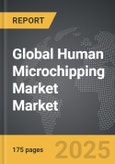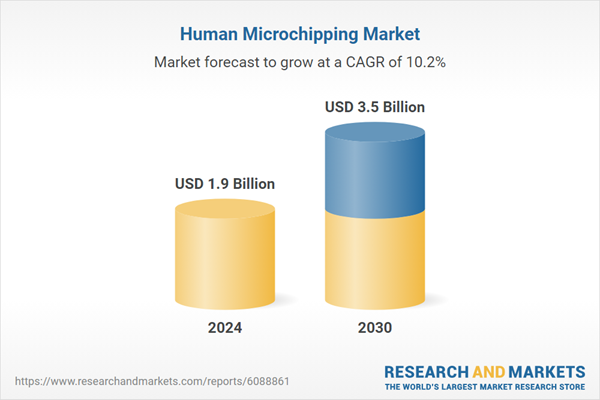Global Human Microchipping Market - Key Trends & Drivers Summarized
Why Is Human Microchipping Gaining Momentum in Identity, Health, and Access Technologies?
Human microchipping - embedding small RFID or NFC-enabled chips under the skin - is emerging as a controversial yet increasingly viable solution for identity authentication, secure access, and medical data storage. These subdermal implants are typically the size of a grain of rice and are injected in areas like the hand or forearm. Once embedded, they can transmit unique identifiers to compatible readers, enabling users to unlock doors, make payments, or retrieve medical data without carrying physical devices.With growing interest in biometric and contactless solutions, microchips are being positioned as the next frontier in personal digital identity. In security-conscious environments such as defense facilities, smart buildings, and data centers, human implants offer a tamper-resistant, always-on alternative to key cards and passwords. Additionally, interest in digital health records and real-time patient tracking is fostering pilot programs involving chip implants in healthcare settings. These applications reflect a convergence of convenience, miniaturization, and wearable technology that is reshaping how personal data and access control are managed.
How Are Technological and Ethical Considerations Influencing Development?
The technology behind human microchipping is evolving rapidly. Next-generation implants now feature encrypted communication, passive power (requiring no battery), and integration with blockchain for secure data verification. Some advanced models are capable of temperature sensing, glucose monitoring, or biosignal transmission, potentially extending into chronic disease monitoring or emergency medical use. However, most current commercial offerings are limited to passive ID functions using ISO-compliant RFID/NFC formats.Privacy and bioethics are key concerns slowing widespread adoption. Regulatory frameworks around data security, informed consent, and bodily autonomy are still in development in many regions. In the EU, for instance, such implants are governed under GDPR when storing personal data, while in the U.S., oversight remains fragmented. The risk of surveillance misuse, social inequity, or involuntary implantation has prompted calls for legal safeguards and ethical guidelines. Public perception is also a barrier - while some embrace the technology for its futuristic potential, others reject it due to fears of loss of agency or dystopian implications.
Where Is Adoption Taking Root, and What Use Cases Are Emerging?
Adoption remains limited but is gaining traction in specific niche markets. In Sweden, a notable early-adopting country, several thousand individuals have opted for implants to access office buildings, public transport, or make digital payments. In corporate environments, some companies are piloting microchip programs for secure facility access and attendance tracking. These programs are often voluntary and paired with incentives or broader wellness programs.In healthcare, researchers are testing implantable chips to store encrypted medical data, allowing emergency responders or clinicians to instantly access patient history, allergies, or implant records. In sports and military settings, chips may be used for real-time monitoring of vitals or location tracking. Meanwhile, startups in North America and Europe are marketing microchips to tech-forward consumers for lifestyle enhancement - such as controlling smart home devices or storing contact information. As technology becomes more refined and socially normalized, broader applications may emerge in travel, voting, and digital wallets.
The Growth in the Human Microchipping Market Is Driven by Several Factors…
It is driven by a growing demand for secure digital identity, frictionless authentication, and real-time health data management. The miniaturization of sensors and rise of the Internet of Bodies (IoB) are enabling implants that go beyond access control to offer biometric sensing and health-related features. Increasing investments in smart infrastructure and secure corporate environments are also generating use cases for embedded human-ID systems.Rising acceptance of body-integrated technology - spurred by wearables, health trackers, and biohacking culture - is gradually improving consumer openness to implants. Additionally, the expansion of contactless ecosystems (payments, access, logistics) is enhancing the utility of always-on, implantable tags. The integration of blockchain, encryption, and biometric encryption is mitigating security concerns and making the technology more scalable. Regulatory frameworks and societal norms will determine the pace of growth, but the convergence of security, health, and identity needs is steadily propelling human microchipping from speculative to practical.
Report Scope
The report analyzes the Human Microchipping market, presented in terms of market value (US$). The analysis covers the key segments and geographic regions outlined below:- Segments: Technology (RFID, NFC, Other Technologies); Type (Implantable Microchips, Non-Implantable Microchips); Application (Medical Identification, Monitoring, Personal Identification, Access Control, Financial Transactions, Other Applications).
- Geographic Regions/Countries: World; United States; Canada; Japan; China; Europe (France; Germany; Italy; United Kingdom; and Rest of Europe); Asia-Pacific; Rest of World.
Key Insights:
- Market Growth: Understand the significant growth trajectory of the RFID Technology segment, which is expected to reach US$1.9 Billion by 2030 with a CAGR of a 8.6%. The NFC Technology segment is also set to grow at 12.6% CAGR over the analysis period.
- Regional Analysis: Gain insights into the U.S. market, valued at $510.4 Million in 2024, and China, forecasted to grow at an impressive 9.4% CAGR to reach $538.3 Million by 2030. Discover growth trends in other key regions, including Japan, Canada, Germany, and the Asia-Pacific.
Why You Should Buy This Report:
- Detailed Market Analysis: Access a thorough analysis of the Global Human Microchipping Market, covering all major geographic regions and market segments.
- Competitive Insights: Get an overview of the competitive landscape, including the market presence of major players across different geographies.
- Future Trends and Drivers: Understand the key trends and drivers shaping the future of the Global Human Microchipping Market.
- Actionable Insights: Benefit from actionable insights that can help you identify new revenue opportunities and make strategic business decisions.
Key Questions Answered:
- How is the Global Human Microchipping Market expected to evolve by 2030?
- What are the main drivers and restraints affecting the market?
- Which market segments will grow the most over the forecast period?
- How will market shares for different regions and segments change by 2030?
- Who are the leading players in the market, and what are their prospects?
Report Features:
- Comprehensive Market Data: Independent analysis of annual sales and market forecasts in US$ Million from 2024 to 2030.
- In-Depth Regional Analysis: Detailed insights into key markets, including the U.S., China, Japan, Canada, Europe, Asia-Pacific, Latin America, Middle East, and Africa.
- Company Profiles: Coverage of players such as A-iPower, Aksa Power Generation, Briggs & Stratton, Champion Power Equipment, Cummins Inc. and more.
- Complimentary Updates: Receive free report updates for one year to keep you informed of the latest market developments.
Some of the 39 companies featured in this Human Microchipping market report include:
- Applied Digital Solutions
- ARM Holdings plc
- Avid Identification Systems
- Baja Beach Club
- Biohax International AB
- BioTeq Ltd.
- Cherry Biotech SAS
- Chip AG
- Dangerous Things LLC
- Digiwell
- EpiCenter
- Grindhouse Wetware
- Kaspersky Lab
- McAfee Corp.
- Micronit Microtechnologies B.V.
- Neuralink Corporation
- NXP Semiconductors N.V.
- Somark Innovations
- Symantec Corporation
- Texas Instruments Inc.
This edition integrates the latest global trade and economic shifts into comprehensive market analysis. Key updates include:
- Tariff and Trade Impact: Insights into global tariff negotiations across 180+ countries, with analysis of supply chain turbulence, sourcing disruptions, and geographic realignment. Special focus on 2025 as a pivotal year for trade tensions, including updated perspectives on the Trump-era tariffs.
- Adjusted Forecasts and Analytics: Revised global and regional market forecasts through 2030, incorporating tariff effects, economic uncertainty, and structural changes in globalization. Includes historical analysis from 2015 to 2023.
- Strategic Market Dynamics: Evaluation of revised market prospects, regional outlooks, and key economic indicators such as population and urbanization trends.
- Innovation & Technology Trends: Latest developments in product and process innovation, emerging technologies, and key industry drivers shaping the competitive landscape.
- Competitive Intelligence: Updated global market share estimates for 2025, competitive positioning of major players (Strong/Active/Niche/Trivial), and refined focus on leading global brands and core players.
- Expert Insight & Commentary: Strategic analysis from economists, trade experts, and domain specialists to contextualize market shifts and identify emerging opportunities.
Table of Contents
Companies Mentioned (Partial List)
A selection of companies mentioned in this report includes, but is not limited to:
- Applied Digital Solutions
- ARM Holdings plc
- Avid Identification Systems
- Baja Beach Club
- Biohax International AB
- BioTeq Ltd.
- Cherry Biotech SAS
- Chip AG
- Dangerous Things LLC
- Digiwell
- EpiCenter
- Grindhouse Wetware
- Kaspersky Lab
- McAfee Corp.
- Micronit Microtechnologies B.V.
- Neuralink Corporation
- NXP Semiconductors N.V.
- Somark Innovations
- Symantec Corporation
- Texas Instruments Inc.
Table Information
| Report Attribute | Details |
|---|---|
| No. of Pages | 175 |
| Published | December 2025 |
| Forecast Period | 2024 - 2030 |
| Estimated Market Value ( USD | $ 1.9 Billion |
| Forecasted Market Value ( USD | $ 3.5 Billion |
| Compound Annual Growth Rate | 10.2% |
| Regions Covered | Global |









